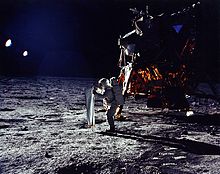Solar Wind Composition Experiment
The Solar Wind Composition (SWC) experiment was the only non-US experiment on the Apollo 11 mission. It involved capturing particles of the solar wind in an exposed aluminum foil and analyzing them in the laboratory after returning from the Moon. The target, measuring 1.40 meters by 0.3 meters, is known as the solar wind sail and was placed in the ground of the Moon by astronaut Buzz Aldrin on July 21, 1969, before the American flag, so as not to waste valuable time on this experiment.
The experiment was significantly planned and evaluated by Johannes Geiss at the Physics Institute of the University of Bern, Switzerland. Results include isotopic ratios of the noble gases helium, neon and argon in the solar wind, upper limits for an atmosphere and a magnetic field of the Moon (from the narrow directional distribution of particle tracks in the aluminum), and clues to acceleration mechanisms (from the energy distribution). The simple, lightweight, and successful experiment has been repeated on all lunar missions except the last Apollo 17 mission and the failed Apollo 13 mission. During the last execution at Apollo 16, two segments of the sail consisted of platinum foil, which allowed a more intensive cleaning.
The whole device weighed 430 grams, which earned the experiment from Bern the compliment "most science per pound" from astronaut circles. NASA Science Director Thomas H. Zurbuchen described the results of the Solar Wind Composition Experiment as an "incredibly important measurement" during the anniversary celebrations in Bern in June 2019.
· 
Solar wind sail (Photo: Apollo 11, detail NASA image AS11-40-5916)
· ![]()
Drawing of the solar wind sail in transport configuration
· 
Drawing of the solar wind sail of Apollo 11
· 
Modified solar wind sail (Photo: Apollo 16, NASA image AS16-117-18849)

Aldrin aligning the Bern solar wind sail (Photo: Apollo 11, NASA image AS11-40-5872)
Questions and Answers
Q: What is the Solar Wind Composition Experiment (SWC)?
A: The Solar Wind Composition Experiment (SWC) was an experiment that was conducted on the Moon during the Apollo program to measure the solar wind outside of Earth's magnetosphere.
Q: What was the purpose of the SWC experiment?
A: The purpose of the SWC experiment was to measure the ion types and energies of the solar wind on the lunar surface.
Q: Who suggested the SWC experiment?
A: The SWC experiment was suggested by a Swiss team headed by Johannes Geiss of the University of Bern and Peter Eberhardt of the Swiss Institute of Technology.
Q: Was the SWC experiment funded by the Swiss Government?
A: Yes, the SWC experiment was partially funded by the Swiss Government.
Q: How was the SWC experiment conducted?
A: The SWC experiment was conducted by getting an aluminum sheet and facing it towards the sun to collect the ion types and energies of the solar wind. After the experiment, the sheet was placed into a Teflon bag and sent back to Earth to be studied.
Q: What did the SWC experiment find?
A: The SWC experiment found Helium, Neon and Argon isotopic compositions coming from the sun.
Q: Was the SWC experiment successful?
A: Yes, the SWC experiment was successful in measuring the solar wind outside of Earth's magnetosphere and discovering the isotopic compositions of the solar material.
Search within the encyclopedia